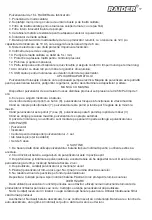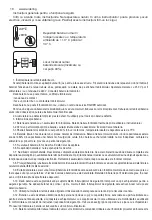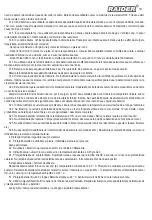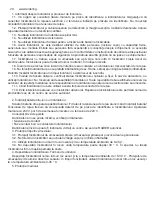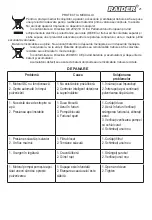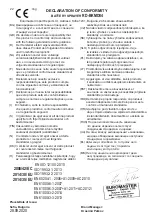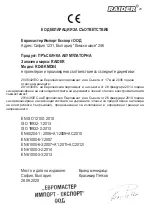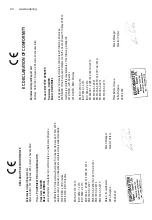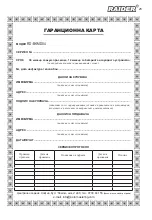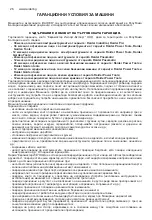
12
www.raider.bg
BATTERY
General guidelines for safe operation.
Read all instructions carefully. Failure of the nature following instructions can cause electric shock, fire and
/ or severe injuries. Keep these instructions in a safe place.
3
3
Store the battery only in
dry rooms with an ambient
temperature of +10°C to +30°C.
Place only charged
batteries in storage (charged at
least 40%).
1. Charge the lithium- ion rechargeable battery.
Remove the battery from the handle, press the button down to do this. Pay attention to mains voltage when charging the battery!
The mains voltage must match the data on the charger label. Appliances marked with 230 V can also be powered with a voltage of
220 V. Connect the battery to the charger.
If the battery can not charge, check the following:
• contact voltage
• makes good contact with the charger contacts
If the battery can not be charged again, visit an authorized RAIDER service center.
To make sure that the lithium-ion rechargeable battery will last longer, you must recharge it immediately. You must recharge the
battery when you notice that the power of the cordless tool is decreasing.
2. Тhe battery has completely broken down and defective. Do not use or charge a defective battery.
3. Information on the battery.
3.1 The battery is supplied with your cordless tool uncharged. The battery needs to be charged before using the tool for the first
time.
3.2 For optimum battery performance, avoid weak discharge cycles. Charge the battery frequently.
3.3 Store the rechargeable battery at least 40% in a cool place, the ideal storage temperature is 15
0
C.
3.4 Lithium-ion batteries are subject to a natural aging process. The battery should be replaced when the capacity drops to 80%
of the capacity of a new battery. Leaking cells in an old rechargeable battery no longer meet the power requirements and therefore
cause a safety hazard.
3.5 Do not throw the batteries in open fire. There is a risk of explosion.
3.6 Do not ignite batteries or expose them to naked flames.
3.7. Do not dilute the batteries completely. Full discharge will damage battery cells. The most common cause of complete dilution
is the prolonged storage and non-use of partially diluted batteries. Stop working as soon as the battery becomes noticeably exhausted
or the electronics protection system works. Only recharge the storage battery after it is fully charged.
3.8. Protect rechargeable batteries and tools from overloading! Overloading will result in overheating and damage to the cells in
the battery without external heating.
3.9. Avoid damage and shocks. Replace rechargeable batteries that have dropped from a height of more than one meter or that
have been subject to sharp shocks even if the battery case looks undamaged. The batteries in the battery can be seriously damaged.
In this regard, read the waste treatment information.
3.10. If the battery is overloaded and overheated, the built-in safety switch will turn off the equipment to ensure safety. Do not press
the on / off switch. more if the safety switch is activated. This could damage the battery.
3.11. Only use original rechargeable batteries. The use of other batteries may result in injuries and the risk of fire.
3.12. The battery is not intended for use by persons (including children) with limited physical, sensory or mental capabilities, or for
persons without experience and knowledge of the equipment, unless the use is monitored or used in accordance with the instruction

















